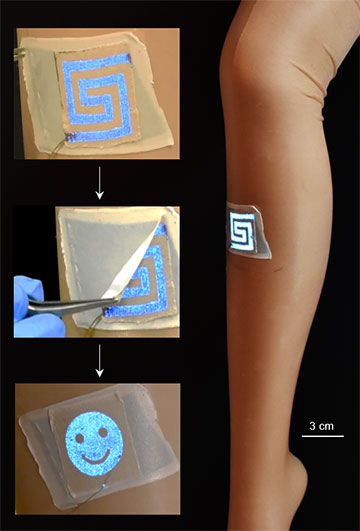
The changeable patterned e-textile worn on pantyhose over a mannequin leg. [Image: The Carmichael Lab]
Light-emitting textiles have the potential to expand the capabilities of clothing in the realms of fashion, advertising, sports and worker safety. Current approaches mostly include sewing electronic components, optical fibers and light-emitting diodes (LEDs) directly into fabric. However, clothing made in this way suffers from rigidity and bulkiness, making it relatively uncomfortable to wear.
A team of researchers from the University of Windsor, Canada, reports a new technique for the fabrication of light-emitting textiles that deposits metal directly on the individual fibers of an ultrasheer fabric (Matter, doi: 10.1016/j.matt.2020.01.017). The method produces a wearable, conductive and highly stretchable electronic textile.
Comfortable smart clothing
Wearable electronics like smart watches and activity trackers have already broken into the mainstream, and many experts believe that smart clothing represents the next step. Smart clothing may have sensors to detect biometric data, batteries or solar cells as power sources, and LEDs to display patterns or data output.
More often than not, today’s smart clothing is made by simply stitching electronic components into the fabric. But having stiff optical fibers running through a sweater or an inflexible electrode in the sleeve of a workout shirt is less than ideal. Clothing should be comfortable, durable and washable—attributes that conflict with the vast majority of electronic parts.
“Instead of trying to apply conventional thin-film device-fabrication methods to fabrics, we wanted to see if we could use the intrinsic structure of the fabric as an integral part of the design,” said Tricia Carmichael, senior author and professor of surface and materials chemistry at the University of Windsor.
Conductive pantyhose

Light-emitting textiles displaying a smiley face emoji, a rectangular spiral and the number 8. [Image: The Carmichael Lab]
Carmichael and her colleagues started with an ultrasheer knitted fabric made of 87% nylon and 13% spandex—pantyhose. They used electroless nickel-immersion gold metallization, a solution-based technique commonly used in printed circuit board fabrication, to deposit a gold metal film on the surface of the fibers. Scanning electron microscopy confirmed that both the nylon and spandex fibers had an approximately 100-nm thick uniform gold coating. The pantyhose material retained its softness, stretchiness and transparency.
“We found that the technique was a good way to integrate metal into fabrics, and that it could coat even tiny fibers with metal,” said Carmichael. “The resulting textile still feels like fabric, just shinier, and the conductivity is very good.”
The gold-coated ultrasheer fabric exhibited an average sheet resistance of 3.6 ohms per square, which is slightly higher than the sheet resistance of a flat gold film of similar thickness. The conductivity of the textile remained remarkably stable throughout durability testing, which included 200% strain in both directions and a thousand repeated stretching episodes of 50% strain. The fabric also successfully withstood 10 simulated laundry cycles, complete with laundry detergent, agitation and a drying cycle.
Futuristic fabrics
Lastly, the researchers used a low-cost stencil-printing method to fabricate patterned e-textile electrodes in the shape of a smiley face and a dynamic display of the numbers 0 to 9. A cold-wax medium was applied to the pantyhose before metallization to act as a stencil and dissolved afterwards to create the different patterns.
“We see this technique being used for any application where self-illumination provides an advantage. Anybody working at night where visibility is important, like first responders, or even people walking around at night,” said Carmichael. “My strength is not coming up with fashion ideas, but when this type of fabric is available, it tends to capture people’s imagination.”
